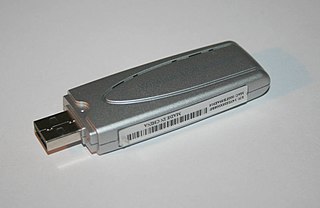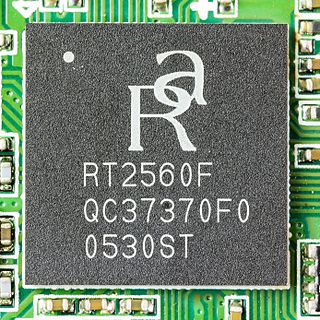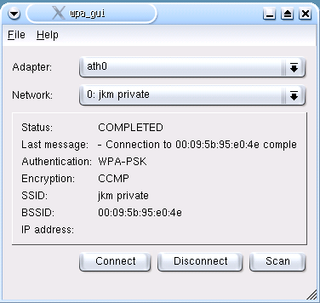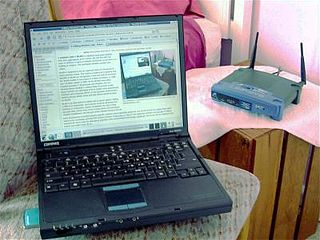802.11b/g products (Prism54, ISL38xx)
The chipset has undergone a major redesign for 802.11g compatibility and cost reduction, and newer "Prism54" chipsets are not compatible with their predecessors.
Intersil initially provided a Linux driver for the first Prism54 chips which implemented a large part of the 802.11 stack in the firmware. However, further cost reductions caused a new, lighter firmware to be designed and the amount of on-chip memory to shrink, making it impossible to run the older version of the firmware on the latest chips. In the meantime, the PRISM business was sold to Conexant, which never published information about the newer firmware API that would enable a Linux driver to be written.
However, a reverse engineering effort eventually made it possible to use the new Prism54 chipsets under the Linux and BSD operating systems.

Wi-Fi Protected Access (WPA), Wi-Fi Protected Access II (WPA2), and Wi-Fi Protected Access 3 (WPA3) are three security protocols and security certification programs developed by the Wi-Fi Alliance to secure wireless computer networks. The Alliance defined these in response to serious weaknesses researchers had found in the previous system, Wired Equivalent Privacy (WEP).
IEEE 802.11i-2004, or 802.11i for short, is an amendment to the original IEEE 802.11, implemented as Wi-Fi Protected Access II (WPA2). The draft standard was ratified on 24 June 2004. This standard specifies security mechanisms for wireless networks, replacing the short Authentication and privacy clause of the original standard with a detailed Security clause. In the process, the amendment deprecated broken Wired Equivalent Privacy (WEP), while it was later incorporated into the published IEEE 802.11-2007 standard.
A wireless distribution system (WDS) is a system enabling the wireless bridging of access points in an IEEE 802 network. It allows an extended network to be created using wireless IEEE 802.11 (Wi-Fi) access points without the traditional requirement for wires to link them. The notable advantage of WDS over other solutions is that it preserves the MAC addresses of client frames across links between access points, thus mixtures of ethernet and WDS connections can be treated as a single network.

A wireless network interface controller (WNIC) is a network interface controller which connects to a wireless radio-based computer network, rather than a wired network, such as Token Ring or Ethernet. A WNIC, just like other NICs, works on the Layer 1 and Layer 2 of the OSI Model. This card uses an antenna to communicate via microwave radiation. A WNIC in a desktop computer is traditionally connected using the PCI bus. Other connectivity options are USB and PC card. Integrated WNICs are also available,.

Ralink Technology, Corp. was a Wi-Fi chipset manufacturer mainly known for their IEEE 802.11 chipsets. Ralink was founded in 2001 in Cupertino, California, then moved its headquarters to Hsinchu, Taiwan.

Wireless security is the prevention of unauthorized access or damage to computers or data using wireless networks. The most common types of wireless security are Wired Equivalent Privacy (WEP) and Wi-Fi Protected Access (WPA). WEP is a notoriously weak security standard: the password it uses can often be cracked in a few minutes with a basic laptop computer and widely available software tools. WEP is an old IEEE 802.11 standard from 1997, which was superseded in 2003 by WPA, or Wi-Fi Protected Access. WPA was a quick alternative to improve security over WEP. The current standard is WPA2; some hardware cannot support WPA2 without firmware upgrade or replacement. WPA2 uses an encryption device that encrypts the network with a 256-bit key; the longer key length improves security over WEP. Enterprises often enforce security using a certificate-based system to authenticate the connecting device, following the standard 802.1X.
IEEE 802.11w-2009 is an approved amendment to the IEEE 802.11 standard to increase the security of its management frames.

wpa_supplicant is a free software implementation of an IEEE 802.11i supplicant for Linux, FreeBSD, NetBSD, QNX, AROS, Microsoft Windows, Solaris, OS/2 and Haiku. In addition to being a fully featured WPA2 supplicant, it also implements WPA and older wireless LAN security protocols.

High-speed multimedia radio (HSMM) is the implementation of wireless data networks over amateur radio frequencies using commercial off-the-shelf (COTS) hardware such as 802.11 access points. Only licensed amateur radio operators may use amplifiers and specialized antennas to increase the power and coverage of the 802.11 signal.
Qualcomm Atheros is a developer of semiconductors for network communications, particularly wireless chipsets. Founded under the name T-Span Systems in 1998 by experts in signal processing and VLSI design from Stanford University, the University of California, Berkeley and private industry. The company was renamed Atheros Communications in 2000 and it completed an initial public offering in February 2004 trading on NASDAQ under the symbol ATHR.
hostapd is a user space daemon software enabling a network interface card to act as an access point and authentication server. There are three implementations: Jouni Malinen's hostapd, OpenBSD's hostapd and Devicescape's hostapd.

Aircrack-ng is a network software suite consisting of a detector, packet sniffer, WEP and WPA/WPA2-PSK cracker and analysis tool for 802.11 wireless LANs. It works with any wireless network interface controller whose driver supports raw monitoring mode and can sniff 802.11a, 802.11b and 802.11g traffic. The program runs under Linux, FreeBSD, OS X, OpenBSD, and Windows; the Linux version is packaged for OpenWrt and has also been ported to the Android, Zaurus PDA and Maemo platforms; and a proof of concept port has been made to the iPhone.

Wireless network cards for computers require control software to make them function. This is a list of the status of some open-source drivers for 802.11 wireless network cards.
NoWires Needed was a Dutch company specializing in IEEE 802.11 wireless WLAN technology. It was founded in Bilthoven, in the Netherlands in 1994.

ORiNOCO was the brand name for a family of wireless networking technology by Proxim Wireless. These integrated circuits provide wireless connectivity for 802.11-compliant Wireless LANs.

WaveLAN was a brand name for a family of wireless networking technology sold by NCR, AT&T, and Lucent, as well as being sold by other companies under OEM agreements. The WaveLAN name debuted on the market in 1988 and was in use into the mid-1990s, when Lucent renamed their products to ORiNOCO. WaveLAN laid the important foundation for the formation of IEEE 802.11 working group and the resultant creation of Wi-Fi.
The DG834 series are popular ADSL modem router products from Netgear. The devices can be directly connected to the phone line and establish an ADSL broadband Internet connection to the ISP and share it among several computers via 802.3 Ethernet and 802.11b/g wireless data links.











